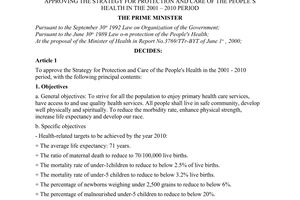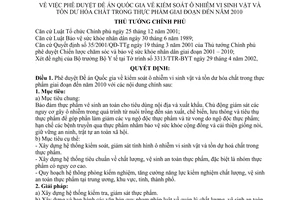Nội dung toàn văn Decision No. 28/QD-TTg of January 6, 2003, approving the national scheme on control of micro-organism contamination and chemical residues in foodstuffs in the period from now till 2010
|
THE
PRIME MINISTER OF GOVERNMENT |
SOCIALIST REPUBLIC OF VIET NAM |
|
No: 28/QD-TTg |
Hanoi , January 6, 2003 |
DECISION
APPROVING THE NATIONAL SCHEME ON CONTROL OF MICRO-ORGANISM CONTAMINATION AND CHEMICAL RESIDUES IN FOODSTUFFS IN THE PERIOD FROM NOW TILL 2010
THE PRIME MINISTER
Pursuant to the December 25,
2001 Law on Organization of the Government;
Pursuant to the June 30, 1989 Law on the Protection of People’ s Health;
Pursuant to the Prime Minister ‘s Decision No. 35/2001/QD-TTg of March 19, 2001
approving the strategy for care and protection of the people ‘s health in the
2001-2010 period;
At the proposal of the Minister of Health in Report No. 3313/TTr-BYT of April
29, 2002,
DECIDES:
Article 1.- To approve the national scheme on control of micro-organism contamination and chemical residues in foodstuffs in the period from now till 2010 with the following principal contents:
1. Objectives:
a/ General objectives:
To ensure hygienic and safe foodstuffs for domestic consumption and export. To take initiative in supervising the danger of contamination in the process from farming to production, processing, circulation and consumption of foodstuffs, thus contributing to reducing the cases of foodstuff poisoning and mortality due to foodstuff poisoning; and limiting the foodstuff-transmitted diseases in order to protect the community’s health and improve our race, and maintain security, order and social safety.
b/ Specific objectives:
- To build the system of controlling and monitoring the situation of micro-organism contamination and chemical residues in foodstuffs.
- To build the standard system on quality, hygiene and safety of foodstuffs, especially high-risk foodstuffs.
- To make a planning on the system of laboratories, and to enhance the capability of testing foodstuff quality, hygiene and safety (FQHS) at the central, regional and provincial/municipal levels.
2. Solutions:
a/ To build the foodstuff inspection and supervision system.
b/ To elaborate and promulgate legal documents on FQHS management; the criteria for FQHS evaluation, build and apply mechanisms for handling the violations of the legislation on foodstuff hygiene and safety.
c/ To build and apply models for producing and processing safe foodstuffs throughout the country in service of export and domestic consumption.
d/ To build models for self-management and supervision of the use of plant protection drugs and veterinary drugs in accordance with specifications, and ways of processing safe foodstuffs.
e/ To monitor the assurance of foodstuff hygiene and safety.
f/ To raise the sense of responsibility towards consumers and knowledge of peasants directly engaged in foodstuff production, and of foodstuff enterprises on FQHS.
To enhance communication and education of foodstuff hygiene and safety as well as legal knowledge for peasants and persons directly engaged in foodstuff production and processing, and food catering.
3. Activities for implementation of the scheme:
a/ Project one: Control of micro-organism contamination and chemical residues (including foodstuff additives) in foodstuff products
- Objectives:
To raise the capability to control and limit micro-organisms and toxic chemicals in foodstuffs and foodstuff additives. To take initiative in controlling foodstuff poisoning and limiting diseases caused by the use of contaminated foodstuffs.
- Implementation contents:
+ To build the system of legal documents on foodstuff hygiene and safety.
+ To build the testing system capable of evaluating and controlling foodstuff contamination throughout the country.
+ To build technical standards for evaluation of quality, hygiene and safety of additives used in foodstuff processing and additives retailed on the market in form of raw materials.
+ To build pilot and good models in the application of measures to control foodstuff contamination and foodstuff-transmitted diseases in the supply of foodstuff additives.
- Implementing agencies:
The Ministry of Health shall assume the prime responsibility and coordinate with the concerned ministries and branches.
b/ Project two: Inspection and supervision of biological contamination and chemical residues in farm produce and foodstuffs
- Objectives:
To enhance the inspection, supervision and application of scientific, technical and technological advances in terms of varieties, biological drugs, herbal drugs, biological preparations and organic fertilizers, and advanced technical processes to clean and safe agricultural production for domestic consumers, thus contributing to raising the competitiveness and speeding up the export of farm produce and foodstuffs.
To strive to substantially reduce chemical residues in farm produce and foodstuffs by 2010.
- Implementation contents:
+ To control biological contamination and chemical residues in farm produce.
+ To control foodstuff hygiene and safety in husbandry, slaughtering and husbandry products.
+ To control feed quality, hygiene and safety.
+ To control fertilizer quality.
+ To build areas for manufacturing safe raw-material foodstuffs.
- Implementing agencies:
The Ministry of Agriculture and Rural Development shall assume the prime responsibility and coordinate with the concerned ministries and branches.
c/ Project three: Control of micro-organism contamination and chemical residues in aquatic foodstuffs
- Objectives:
To raise the capability and efficiency to control pathogenic micro-organism contamination and toxic chemical residues in aquatic products in order to protect consumers� health and improve the competitiveness of the Vietnamese aquatic products at home and in the world.
- Implementation contents:
+ To elaborate and perfect the system of legal documents and technical standards relating to aquatic foodstuff hygiene and safety.
+ To enhance the capability to examine foodstuff quality, hygiene and safety criteria in aquaculture feeds, reared and fished aquatic products.
+ To provide training and guidance on the regulations and branch standards on conditions to ensure foodstuff hygiene and safety for organizations and individuals that catch, rear, process, purchase, preserve, transport and/or circulate aquatic products.
+ To monitor, inspect and recognize safe rearing areas, clean rearing farms as well as aquatic product-producing and -trading establishments meeting the foodstuff hygiene and safety standards.
- Implementing agencies:
The Ministry of Aquatic Resources shall assume the prime responsibility and coordinate with the concerned ministries and branches.
d/ Project four: Control of micro-organism contamination and toxic chemical residues in foodstuff processing
- Objectives:
To control the whole process of foodstuff processing, from raw materials to finished products, by managerial and technological measures in order to ensure the product quality up to the foodstuff hygiene and safety requirements, and reduce dangers of micro-organism contamination and toxic chemical residues.
- Implementation contents:
+ To elaborate and promulgate documents on technical standards and processes, as well as the quality management system suitable to Vietnams situation in order to guide the foodstuff-producing and -processing establishments in the application thereof.
+ To build the foodstuff quality, hygiene and safety management network in the foodstuff processing industry.
+ To formulate the program on ensuring FQHS right from raw materials in order to eliminate toxic elements in foodstuff-producing and -processing raw materials.
+ To formulate the program on controlling foodstuff hygiene and safety in the use of technologies and equipment in the foodstuff processing industry.
+ To build a number of models of small- and medium-sized foodstuff processing establishments where Good Manufacturing Practices (GMP), Good Hygiene Practices (GHP) and Hazard Analysis and Critical Control (HACCP) are applied.
- Implementing agencies: The Ministry of Industry shall assume the prime responsibility and coordinate with the concerned ministries and branches.
4. Assignment of responsibilities for implementation direction:
a/ The Ministry of Health:
To control micro-organism contamination and chemical residues in fresh foodstuffs, raw-material foodstuffs, foodstuff additives, functional foodstuffs, high-risk foodstuffs and import foodstuffs; home-made foodstuffs as well as in- and post-processing foodstuffs, for domestic consumption and export.
b/ The Ministry of Agriculture and Rural Development:
To control epidemics of animals and live plants as well as plant varieties and animal breeds, to control biological contamination and chemical residues in products being raw-material foodstuffs first, in the process of producing raw-material foodstuffs (fresh or processed), as well as in the transportation, import and export thereof.
c/ The Ministry of Science and Technology:
To coordinate with the Ministry of Health and the Ministry of Agriculture and Rural Development in elaborating and promulgating the Vietnamese standards on foodstuff quality, hygiene and safety.
d/ The Ministry of Trade:
- To coordinate with the Ministry of Health and the concerned ministries in controlling the trading in foodstuffs on market, especially those foodstuffs highly prone to contamination; controlling foodstuff labels and fake foodstuffs.
- To coordinate with the Ministry of Agriculture and Rural Development in managing the concentrated slaughtering of animals and applying GHP and HACCP at slaughtering establishments.
e/ The Ministry of Industry:
- To control micro-organism contamination and chemical residues in the foodstuff processing.
- To coordinate with the Ministry of Health in building pilot model and applying GHP, GMP and HACCP at medium- and small-sized foodstuff processing establishments.
f/ The Ministry of Aquatic Resources:
To control epidemics of animals and live aquatic plants; micro-organism contamination and chemical residues in products being raw-material foodstuffs first, in the process of producing raw-material foodstuffs (fresh or processed), as well as the transportation and export thereof.
g/ The local People’s Committees:
To coordinate closely with the concerned ministries and branches in elaborating policies on FQHS management and implementing the scheme in their respective localities; to direct Services, Departments and branches in their respective localities to build areas for producing and processing safe foodstuffs; to build concentrated hygienic livestock-slaughtering houses and protect the environment; to build models of communities for monitoring FQHS in communes and wards; and to direct the implementation of measures to ensure FQHS.
5. Funding for implementation
Annually, the Ministry of Health and the concerned ministries shall coordinate with the Ministry of Planning and Investment and the Ministry of Finance in elaborating the plan and funding for implementation of the scheme, then submitting them to the Prime Minister for approval.
Funding sources:
- In the immediate future, in 2002, the funding of the project on ensuring foodstuff quality, hygiene and safety in the national target program on prevention and combat of some social diseases, dangerous epidemics and HIV/AIDS is used.
- From 2003-2010: The scheme shall be financed partly by the State budget, partly by contributions of the foodstuff-producing enterprises, and partly by assistance and support from international organizations.
Article 2.- The Minister of Health shall assume the prime responsibility and coordinate with the concerned ministries and agencies in organizing the implementation of this Decision.
The agencies assuming the prime responsibility for implementing the projects shall have to direct the elaboration of projects and submit them for approval according to regulations; and organize the implementation of projects.
Annually, the Ministry of Health shall assume the prime responsibility for summing up evaluation and reporting on implementation results to the Prime Minister.
Article 3.- This Decision takes effect after its signing.
Article 4.- The Minister of Health, the ministers, the heads of the ministerial-level agencies, the heads of the agencies attached to the Government, and the presidents of the People’s Committees of the provinces and centrally-run cities shall have to implement this Decision.
|
FOR
THE PRIME MINISTER |



